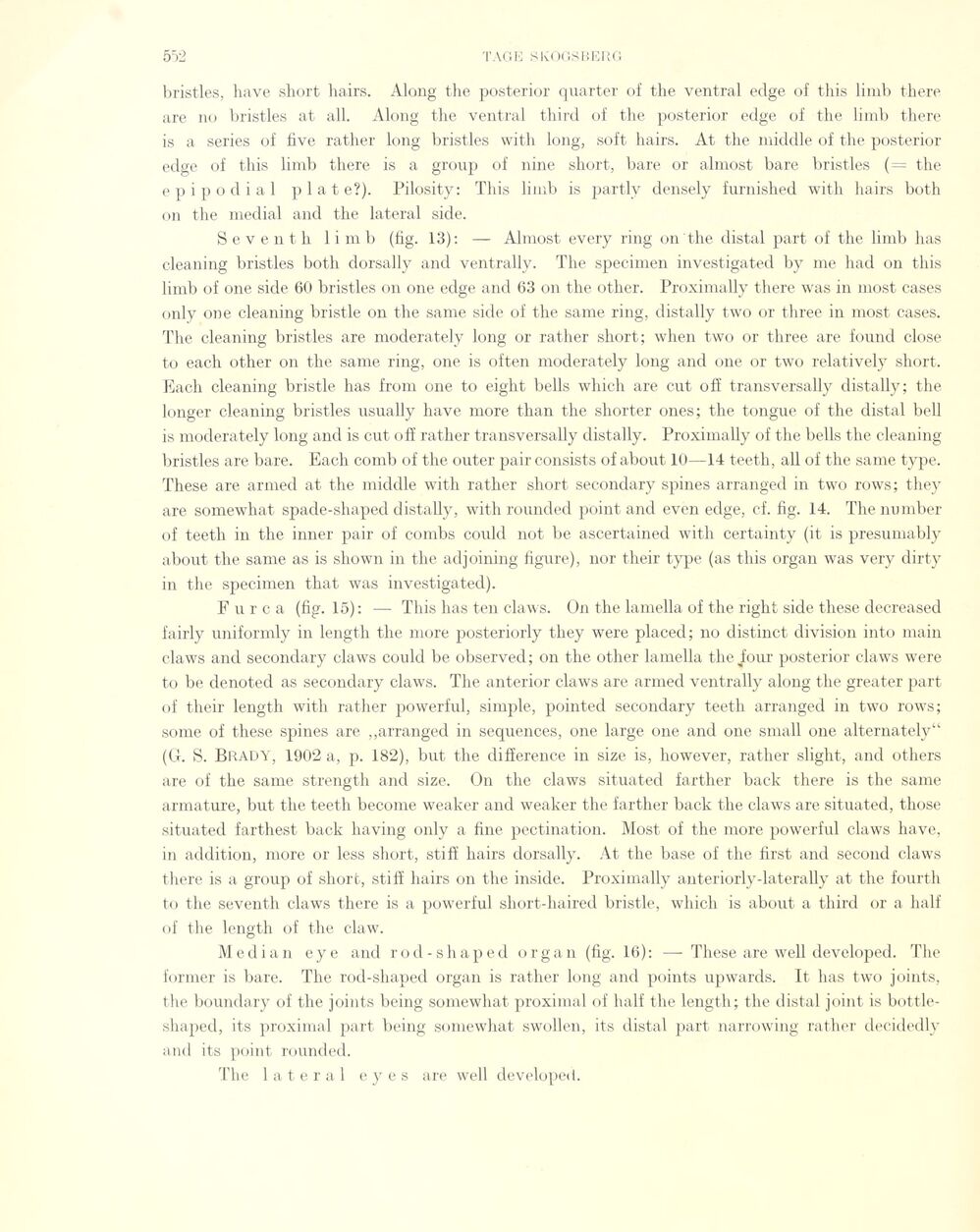
Full resolution (JPEG) - On this page / på denna sida - Sidor ...

<< prev. page << föreg. sida << >> nästa sida >> next page >>
Below is the raw OCR text
from the above scanned image.
Do you see an error? Proofread the page now!
Här nedan syns maskintolkade texten från faksimilbilden ovan.
Ser du något fel? Korrekturläs sidan nu!
This page has never been proofread. / Denna sida har aldrig korrekturlästs.
bristles, have short hairs. Along the posterior quarter of the ventral edge of this limb there
are no bristles at all. Along the ventral third of the posterior edge of the limb there
is a series of five rather long bristles with long, soft hairs. At the middle of the posterior
edge of this limb there is a group of nine short, bare or almost bare bristles (— the
epipodial plate?). Pilosity: This limb is partly densely furnished with hairs both
on the medial and the lateral side.
Seven tli limb (hg. 13): — Almost every ring on the distal part of the limb has
cleaning bristles both dorsally and ventrally. The specimen investigated by me had on this
limb of one side 60 bristles on one edge and 63 on the other. Proximally there was in most cases
only one cleaning bristle on the same side of the same ring, distally two or three in most cases.
The cleaning bristles are moderately long or rather short; when two or three are foimd close
to each other on the same ring, one is often moderately long and one or two relatively short.
Each cleaning bristle has from one to eight bells which are cut off transversally distally; the
longer cleaning bristles usually have more than the shorter ones; the tongue of the distal beil
is moderately long and is cut off rather transversally distally. Proximally of the bells the cleaning
bristles are bare. Each comb of the outer pair consists of about 10—14 teeth, all of the same type.
These are armed at the middle with rather short secondary spines arranged in two rows; they
are somewhat spade-shaped distally, with rounded point and even edge, cf. fig. 14. The number
of teeth in the inner pair of combs could not be ascertained with certainty (it is presumably
about the same as is shown in the adjoining figure), nor their type (as this organ was very dirty
in the specimen that was investigated).
Furca (fig. 15): — This has ten claws. On the lamella of the right side these decreased
fairly uniformly in length the more posteriorly they were placed; no distinct division into main
claws and secondary claws could be observed; on the other lamella the four posterior claws were
to be denoted as secondary claws. The anterior claws are armed ventrally along the greater part
of their length with rather powerful, simple, pointed secondary teeth arranged in two rows;
some of these spines are „arranged in sequences, one large one and one small one alternately“
(Cf. S. Brady, 1902 a, p. 182), but the difference in size is, however, rather slight, and others
are of the same strength and size. On the claws situated farther back there is the same
armature, but the teeth become weaker and weaker the farther back the claws are situated, those
situated farthest back kaving only a fine pectinatiori. Most of the more powerful claws have,
in addition, more or less short, stift’ hairs dorsally. At the base of the first and second claws
there is a group of short, stift hairs on the inside. Proximally anteriorly-laterally at the fourth
to the seventh claws there is a powerful short-haired bristle, which is about a third or a half
of the length of the claw.
Median eye and rod-shaped organ (fig. 16): — These are well developed. The
former is bare. The rod-shaped organ is rather long and points upwards. It has two joints,
the boundary of the joints being somewhat proximal of half the length; the distal joint is
bottle-shaped, its proximal part being somewhat swollen, its distal part narrowing rather decidedly
and its point rounded.
The lateral eyes are well developed.
<< prev. page << föreg. sida << >> nästa sida >> next page >>